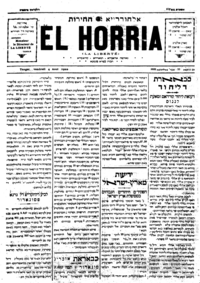Judeo-Moroccan Arabic
| Judeo-Moroccan Arabic | |
|---|---|
 | |
| Native to | Morocco |
| Ethnicity | Moroccan Jews |
Native speakers | 66,000 (2000–2018)[1] |
| Hebrew alphabet | |
| Language codes | |
| ISO 639-3 | aju |
| Glottolog | jude1265 |
| ELP | Judeo-Moroccan Arabic |
Judeo-Moroccan Arabic is the
Nowadays, speakers of the language are usually older adults.
The vast majority of
History and composition
Historically
Widely used in the Jewish community during
Most literate Muslims in Morocco would write, not in vernacular Arabic, but in Standard Arabic, but Moroccan Jews, who typically did not learn Standard Arabic as it was taught in Islamic religious contexts, wrote in Darija using Hebrew script.[4]: 59 For them, Darija was a literary language: Judah ibn Quraish wrote a risala on Semitic languages in Maghrebi Judeo-Arabic to the Jews of Fes already in the ninth-century.[4]: 59
Today
The vast majority of Morocco's 265,000 Jews emigrated to Israel after 1948, with significant emigration to Europe (mainly France) and North America as well. Although about 3,000 Jews remain in Morocco today,
Varieties
Simon Levy identifies three groups of Judeo-Moroccan Arabic based on the pronunciation of the letter qaf (in traditional Maghrebi Arabic script: ق, in Hebrew script: ק): 1) the dialects of Jewish communities in Fez, Sefrou, Meknes, Rabat, and Salé, which pronounce the qāf as a hamza or glottal stop; 2) the dialects of Marrakesh, Essaouira, Safi, el-Jadida, and Azemmour, which pronounce it as a voiced post-velar occlusive [q]; and 3) the dialects of Debdou, Tafilalt, and the Draa River valley, which pronounce it as a voiced velar occlusive [k].[3]
References
- ^ Judeo-Moroccan Arabic at Ethnologue (25th ed., 2022)

- ^ Sibony, Jonas (September 2019). "Curses and profanity in Moroccan Jewish-Arabic and what's left of it in the Hebrew sociolect of Israelis from Moroccan origins". Romano-Arabica. XIX.
- ^ ISSN 0181-4095.
- ^ S2CID 213996367.
- OCLC 1201718554.
- ^ Raymond G. Gordon Jr., ed. 2005. Ethnologue: Languages of the World. 15th edition. Dallas: Summer Institute of Linguistics.
- ^ "EJP | News | France | Jewish pilgrims flock to Morocco to honour celebrated rabbis". Archived from the original on 2012-05-18. Retrieved 2012-05-17.
- ^ "Jewish Language Research Website: Judeo-Arabic". Archived from the original on 21 July 2020.
- S2CID 236561204.
- Heath, Jeffrey, Jewish and Muslim dialects of Moroccan Arabic (Routledge Curzon Arabic linguistics series): London, New York, 2002.
- Stories in Judeo-Arabic by David Bensoussan
External links
- Reka Kol Israelradio station broadcasting a daily program in Judeo-Moroccan (Mugrabian)
